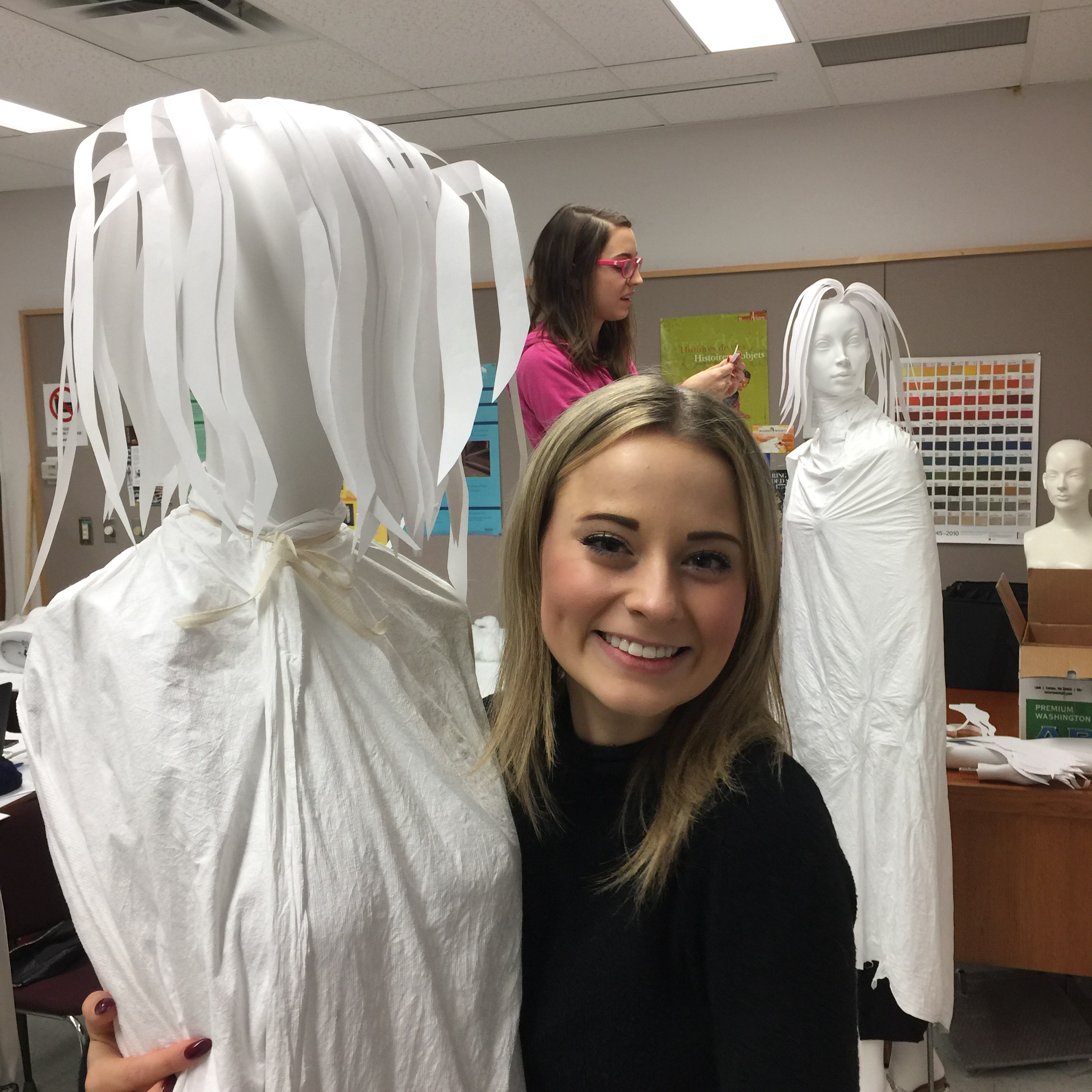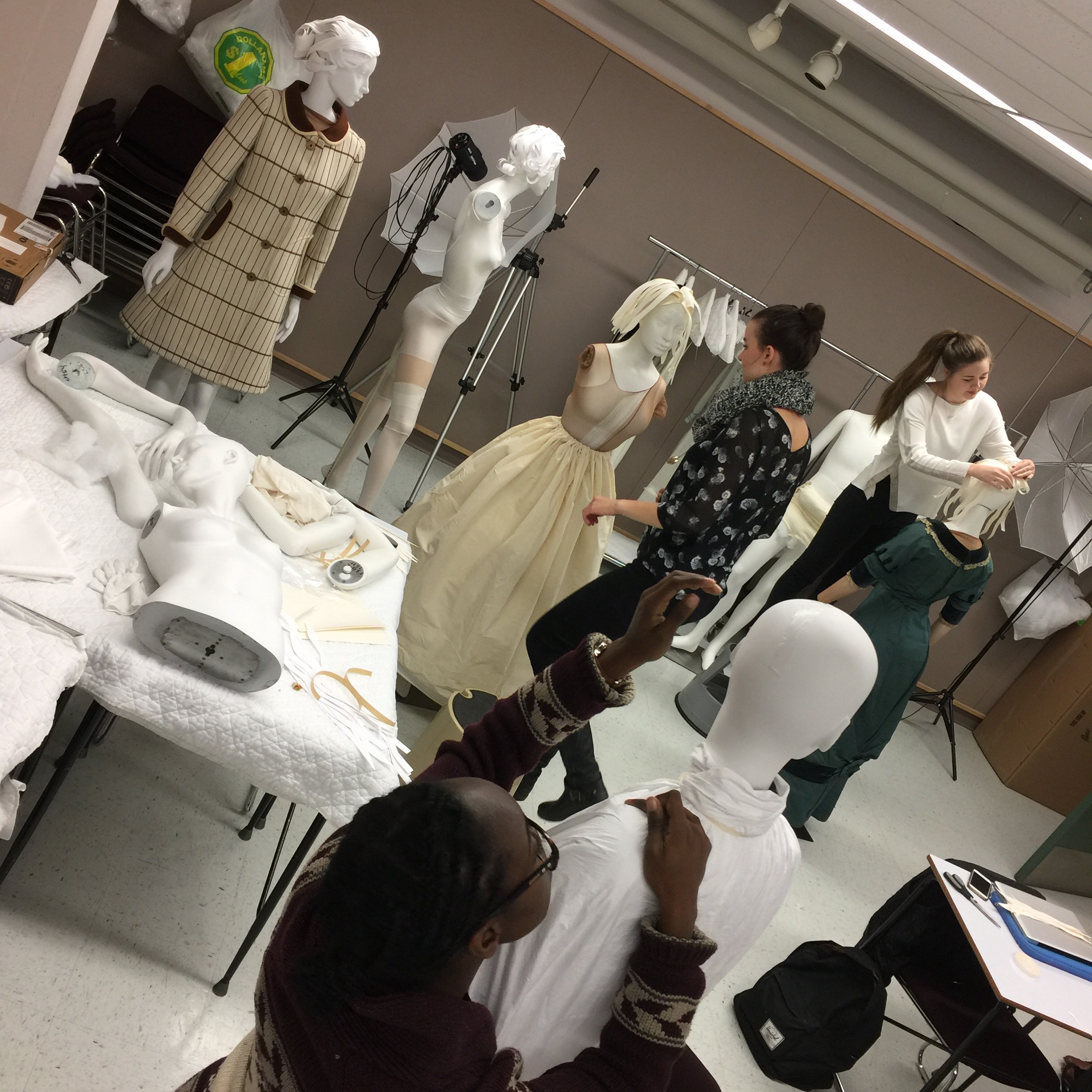 View of the exhibition in the "A Dose of Design" section.
View of the exhibition in the "A Dose of Design" section.
I was stunned and giddy. For the first time in its history, a Richard Martin Award for Excellence in the Exhibition of Costume was given to an exhibition co-curated by students. My students. Our exhibit, Eyewear: Fashion with VisionEyewear: Fashion with Vision, opened in the University of Alberta's Human Ecology Gallery in November 2016, and in May 2017, it received the coveted Costume Society of America award at the organization's annual national conference in the US. Awardees have included major institutions like the Metropolitan Museum of Art in New York and the Royal Ontario Museum in Toronto.
While this was not my first rodeo, it was the first time that I had tried integrating this experiential learning component in the laboratory portion of the undergraduate course "Nineteenth, Twentieth and Twenty-first Century Dress in the Western World." A fabulous way to tackle critical thinking and problem-solving, it engaged students (and members of the community) in a variety of ways.
 Tortoiseshell Sunglasses with Blue Lenses | Samco, Italy, ca. 1970. | Plastic. | Human Ecology's Clothing and Textiles Collection. | Donated by Robert Kully (1998.24.9).
Tortoiseshell Sunglasses with Blue Lenses | Samco, Italy, ca. 1970. | Plastic. | Human Ecology's Clothing and Textiles Collection. | Donated by Robert Kully (1998.24.9).
Exhibitions require both creativity and pragmatism. Unlike my graduate shows where exhibition proposals are voted upon, the topic was selected a month before class started so that crowdfunding activities could begin on day one with the help of the University's partners at USEED. These activities had to be streamlined to be included in the curriculum, which had not been done before. Exhibitions cost money and, in addition to learning fund-raising and PR skills that can be used in real life, the campaign made students consider ideal scenarios and real solutions, including finding community partners that believed in the project. I must admit to being weary about fundraising comparisons amongst students and what I see as potential pestering of friends and family. The group walked that fine line with caution and their enthusiasm on the social media front made it a worthy venture.
Artifact research demands a paradigm shift away from the mass consumption of images to what Ingrid Mida's and Alexandra Kim's The Dress Detective has coined "a slow approach to seeing." Each student selected a garment from the Clothing and Textiles Collection and learned how to handle, observe and contextualize it within a material culture methodology. This allowed them to follow their heart but also opened the door to the grey zones of research where facts, deductions and speculations must be clearly identified. Each student mounted her object, which was subsequently integrated in the exhibition and matched with eyewear from the Collection. They had to select additional artifacts that would convey the message and create an open-ended dialogue with visitors. Local opticians were approached to lend missing frames and became our allies.

 Left: Co-curators Katie Mooney (front) and Cybil Cameron (back) creating paper hair. | The classroom with co-curators Donnalee Riley (front), Naomi Milne (middle ground) and Danielle Peel (back) at work.
Left: Co-curators Katie Mooney (front) and Cybil Cameron (back) creating paper hair. | The classroom with co-curators Donnalee Riley (front), Naomi Milne (middle ground) and Danielle Peel (back) at work.
Students worked in teams to focus on key aspects of eyewear and this is where frustration was most evident: could they find credible scholarly materials that would serve the interdisciplinary nature of the research? Not wanting to loose points on scholarliness, they often found works not applicable to the exhibition. The juggling of simultaneous demands frustrated many but also prepared them well for the complexity of the workplace.
They worked as a group to find solutions, develop the overall narrative and edit text panels. Each step of the way questions arose that had no simple answer. I had to step back and respond with caution to make students identify the issue, formulate solutions and see possible outcomes. Between part-time jobs and multiple classes, they found ways to come in after hours to paint the space, mount additional garments, create historically correct paper hair, install objects, write text panels and labels, and light artifacts. As they were more vocal than graduate students regarding the time spent outside the labs on this project, I must admit to participating to a greater extent than I usually do. The public nature of the exhibition likely pushed all involved to excel; pride is a great motivator!
 Entrance section of the "Eyewear: Fashion with Vision" exhibition.
Entrance section of the "Eyewear: Fashion with Vision" exhibition.
Looking back at the results has deepened my commitment to this form of experiential learning. Not only do exhibitions fit perfectly in the University's Strategic Plan that encourages different ways of learning, but they can merge individual and collaborative learning extremely well. Students involved in exhibition curatorship present the result of their research in a way that is accessible to a variety of University and community constituents who can also share in our success. With this prestigious international award in hand, we strive to let the secret out and make our gallery space and student work jewels in the University's crown.

Dr. Anne Bissonnette - Associate Professor, Material Culture & Curatorship, and Curator, Clothing and Textiles Collection
A curator for over 22 years (8 at the U of A and 14 at the Kent Station University Museum in Ohio), Dr. Bissonnette obtained her PhD in Museum Studies and History at the Union Institute & University (Cincinnati) and her MA in Museum Studies: Costume and Textiles from the Fashion Institute of Technology (New York).